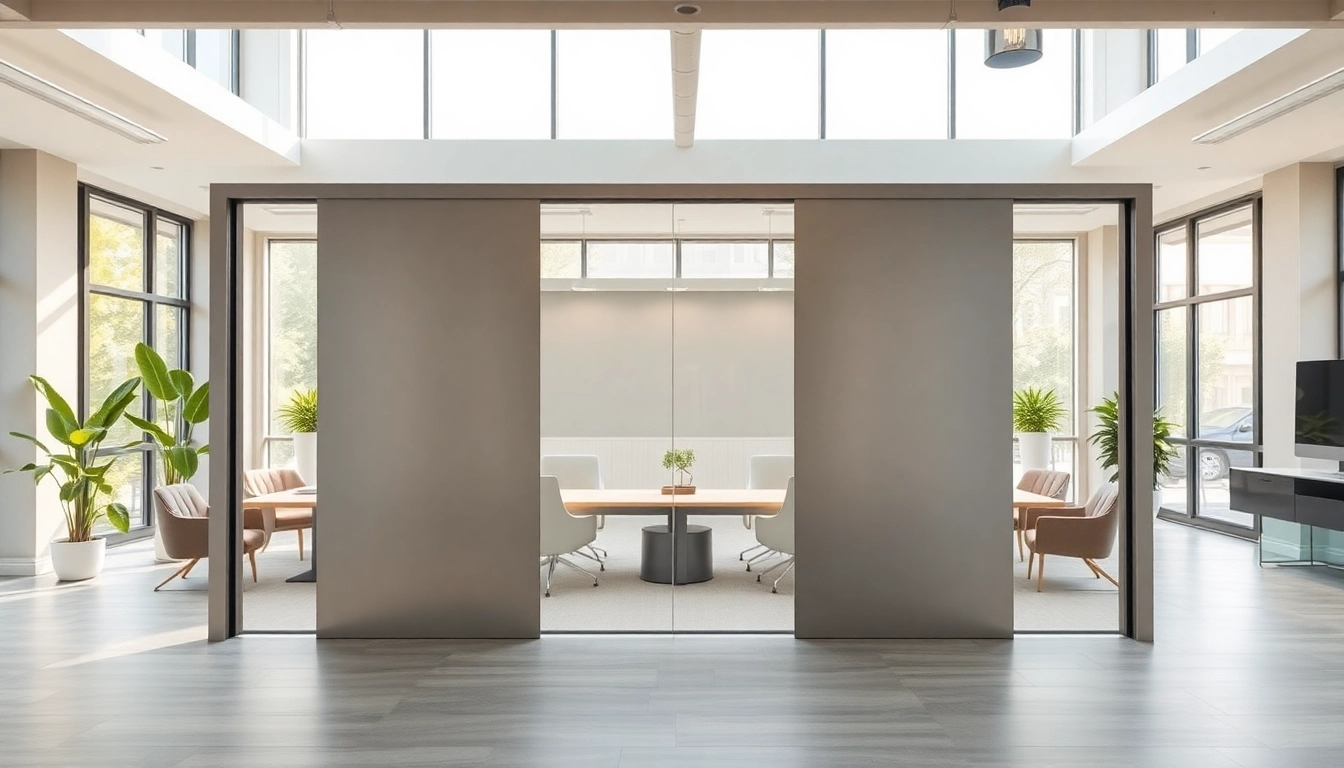
Introduction to Sliding Partition Walls
Sliding partition walls have emerged as a versatile solution for modern spaces, allowing homeowners and businesses alike to maximize their available areas efficiently. These innovative walls offer a unique approach to room management by providing instant flexibility to the layout of any environment. Whether you’re transforming an office, studio apartment, or a multi-functional living space, a sliding partition wall can significantly enhance the usability of your space.
What is a Sliding Partition Wall?
A sliding partition wall is a type of movable wall system that enables you to divide large areas into smaller, more manageable spaces. These walls typically operate on tracks and can slide open or closed based on your needs. This functionality allows for easy adjustments in room size and layout, accommodating various activities, such as meetings, privacy for phone calls, or simple everyday uses in residential areas.
Benefits of Using Sliding Partition Walls
- Space Optimization: Sliding partition walls effectively utilize vertical space without requiring permanent alterations to your structure.
- Flexibility: They provide the ability to quickly change a room’s layout to suit different occasions or requirements.
- Noise Reduction: Many sliding walls feature soundproofing materials that can significantly reduce noise transfer between rooms.
- Aesthetics: Available in a variety of designs and materials, sliding partitions can enhance the visual appeal of a space.
Common Applications of Sliding Partition Walls
Sliding partition walls can be used in an array of settings:
- Corporate Offices: Create boardrooms, meeting spaces, or private offices from large open areas.
- Residential Homes: Divide living areas or bedrooms without the need for a permanent wall.
- Educational Institutions: Enable classrooms to be reconfigured for various teaching methods.
- Hospitality: Allow hotels to adjust their common areas for events and gatherings.
Choosing the Right Sliding Partition Wall
Materials and Design Options
Selecting the correct material for your sliding partition wall is crucial, as it affects aesthetics, functionality, and durability. Options include:
- Wood: Offers warmth and a classic look, perfect for homes and offices.
- Glass: Provides a modern touch while allowing natural light to flow between rooms. Ideal for corporate settings.
- Fabric-Covered Panels: Softens sound and adds color; a popular choice for conference rooms.
Factors to Consider When Selecting
When choosing a sliding partition wall, keep the following factors in mind:
- Space Requirements: Consider the dimensions of the area to ensure a proper fit.
- Usage Frequency: Higher usage may require more durable materials that can withstand wear and tear.
- Installation Method: Some solutions require professional installation, while others are DIY-friendly.
- Budget: Determine a budget that accommodates desired materials and features while fitting within your overall project cost.
Cost Considerations and Budgeting
The cost of sliding partition walls can vary significantly based on materials, size, and installation requirements. Basic systems might start around $1,000, while high-end glass walls can cost several thousand dollars. Always consider your long-term needs, as investing in quality can save you repair or replacement costs down the line.
Installation Process of Sliding Partition Walls
Step-by-Step Installation Guide
Installing a sliding partition wall involves several critical steps to ensure proper functionality:
- Measure the Space: Obtain accurate measurements of the area where the partition will be installed.
- Select Track System: Choose the appropriate track system based on your wall material and intended use.
- Prepare the Area: Clear the installation space and ensure wall and floor surfaces are clean and level.
- Install the Track: Ensure it is securely fastened to the wall or ceiling.
- Hang the Panels: Carefully mount the sliding panels onto the track.
- Test Functionality: Check that the panels slide smoothly and make any necessary adjustments.
Tools and Equipment Needed
A successful installation will require several tools and pieces of equipment:
- Drill and drill bits
- Level
- Measuring tape
- Stud finder
- Screwdriver
- Safety goggles and gloves
Common Installation Challenges
During installation, some challenges may arise:
- Uneven Floors: Use shims to adjust and level the track if necessary.
- Misaligned Tracks: Ensure accurate leveling during installation to prevent sliding issues.
- Weight Management: Select a track system that can handle the weight of the chosen materials.
Maintenance and Care for Sliding Partition Walls
Cleaning and Upkeep Tips
Maintaining your sliding partition walls ensures their longevity and performance. Here are some practical maintenance tips:
- Regular Cleaning: Dust and clean tracks and panels periodically to prevent buildup.
- Lubrication: Apply a silicone-based lubricant to the track and rollers to ensure smooth movement.
- Check for Damage: Inspect regularly for scratches, dents, or other signs of wear.
Inspecting for Wear and Tear
Monitoring for signs of wear can help you catch potential issues before they escalate:
- Listen for unusual noises when sliding the panels to identify potential track issues.
- Look for gaps between the panels that could signify alignment issues.
When to Call a Professional
If you encounter significant installation problems, persistent noise issues, or if damage to the panels or track becomes evident, it’s wise to consult a professional. Their expertise can save time and ensure proper repairs or adjustments are made.
Trends and Innovations in Sliding Partition Walls
Smart Technology Integrations
As technology advances, sliding partition walls have seen innovative enhancements, including smart systems that automatically adjust based on the room’s occupancy or use. Voice-activated controls and remote-access features heighten convenience, making these partitions even more functional.
Eco-friendly Materials and Solutions
With an increasing focus on sustainability, many manufacturers are offering eco-friendly options for sliding partition walls. These include materials sourced from reclaimed woods or recycled products, aligning with efforts to minimize environmental impact.
Future Design Trends in Partition Walls
Future trends point towards aesthetics such as integrated artwork, customizable designs, and modular systems that allow for personalized configurations in both residential and commercial spaces. Sliding partitions are not just functional; they are becoming integral design elements that reflect contemporary styles.